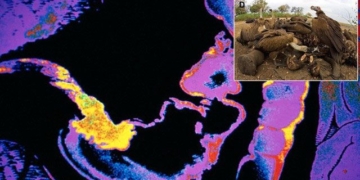In a newly released image by NASA to celebrate the New Year, a cluster of “fireworks” is exploding in the Large Magellanic Cloud, which serves as a “future attacker” of the Milky Way.
According to NASA, the photo was captured by the JPL camera of the “veteran” Hubble Space Telescope. It reveals a phenomenon resembling an explosion in the object barreling straight toward the Milky Way, radiating delicate strands of light in all directions.

The “fireworks” cluster in the Large Magellanic Cloud, a satellite galaxy of the Milky Way – (Photo: NASA).
The mysterious “fireworks” cluster has been identified as a supernova, marking the death of a celestial body.
Meanwhile, the explosion is taking place in the Large Magellanic Cloud, a satellite galaxy of the galaxy containing Earth, known as the Milky Way. The Milky Way is also referred to in Vietnamese as Ngân Hà.
The Milky Way is a massive spiral galaxy. However, due to Earth’s location on the edge of the “light disk”, people see the rest of the galaxy from Earth as a band of light stretching across the sky. Therefore, it is often called the “Milky Way Band.”
Alongside it, the Large Magellanic Cloud and the Small Magellanic Cloud are familiar satellite galaxies. Both are smaller dwarf galaxies.
It is expected that in about 2 billion years, the Large Magellanic Cloud – which is speeding directly toward the Milky Way – will collide.
The collision is anticipated to potentially displace Earth from the “habitable zone” of the Solar System, as well as affect other star systems.
Given the size of the two galaxies, the Large Magellanic Cloud is almost certainly the one that will be swallowed.
In fact, in the past, our Milky Way – a “monster-sized” galaxy – is believed to have consumed around 20 other galaxies.
Although these events are catastrophic, they also trigger powerful star formation, which could lead to the birth of “Earth-like” planets capable of supporting life.


















































